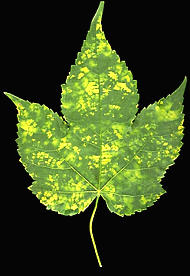 The particles of gemini viruses are quasi-isometric.
They are called gemini (twin) viruses, because they are usually
found in pairs. Each particle has a diameter of just 15 – 20 nm.
Gemini viruses belong to the smallest virus particles able to
multiply without a helper virus. They have a circular DNA with
a molecular weight of 0.7 – 0.8 x 106
(about 2,500 base pairs). In the case of some gemini viruses,
it has been proven, in the case of others, it is assumed,
that the genome consists of two molecules of DNA of almost
equal size, but different sequence. The nucleotide sequences
of some species are known.
The particles of gemini viruses are quasi-isometric.
They are called gemini (twin) viruses, because they are usually
found in pairs. Each particle has a diameter of just 15 – 20 nm.
Gemini viruses belong to the smallest virus particles able to
multiply without a helper virus. They have a circular DNA with
a molecular weight of 0.7 – 0.8 x 106
(about 2,500 base pairs). In the case of some gemini viruses,
it has been proven, in the case of others, it is assumed,
that the genome consists of two molecules of DNA of almost
equal size, but different sequence. The nucleotide sequences
of some species are known.
Isolated circular DNA alone is not infectious. In infected host cells, the nucleus holds the chief amount of viral DNA. It is therefore assumed that the nucleus is also the place of its replication. It looks as if – analogous to the TMV – double-stranded intermediates would exist (= replication state: RF), since double-stranded DNA has been isolated from infected cells. Gemini viruses are of interest to genetic engineers, since they can infect monocots where their DNA enters the nucleus, too, and since the interest in monocot vectors is still large. The bean golden mosaic-virus (BGMV), the cassava latend-virus (CLV), the tomato golden-mosaic-virus (TGMV), the maize-streak virus (MSV), and the abutilon mosaic-virus belong all to the Gemini-virus family.
Insects (greenhouse whitefly, grasshoppers, and others)
help usually in spreading Gemini-viruses in nature. These
viruses can cause considerable damage to agriculture.
|
|